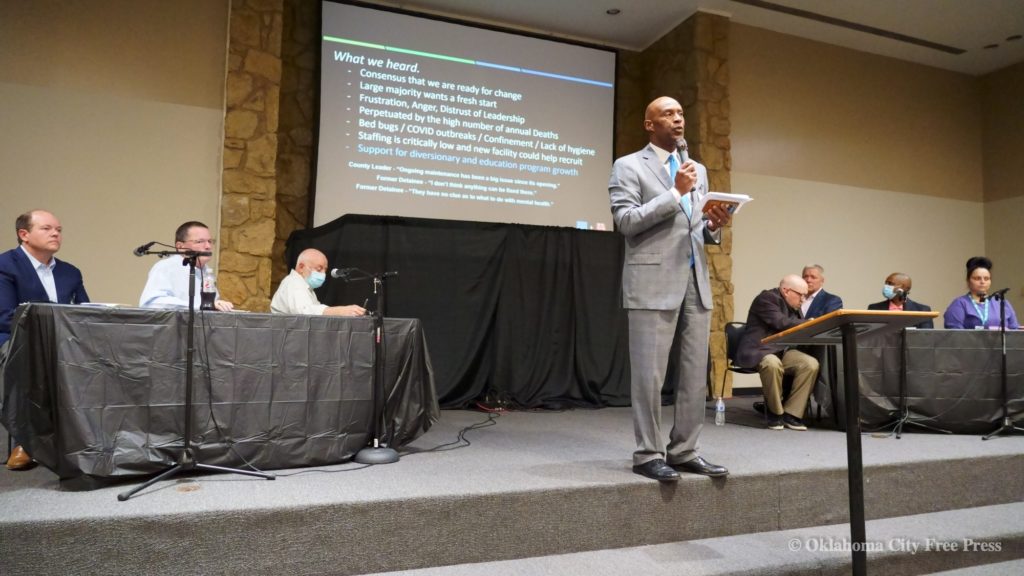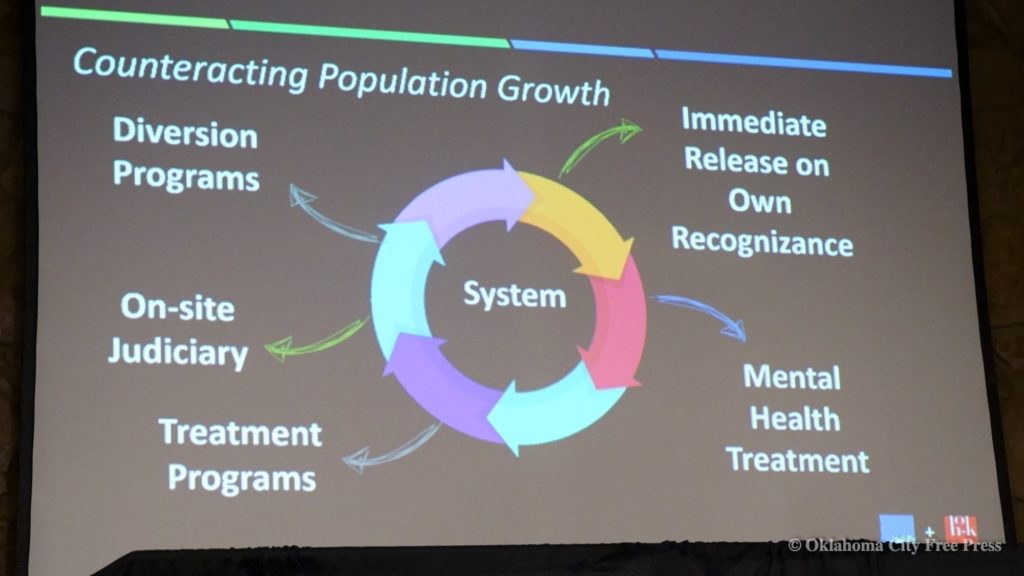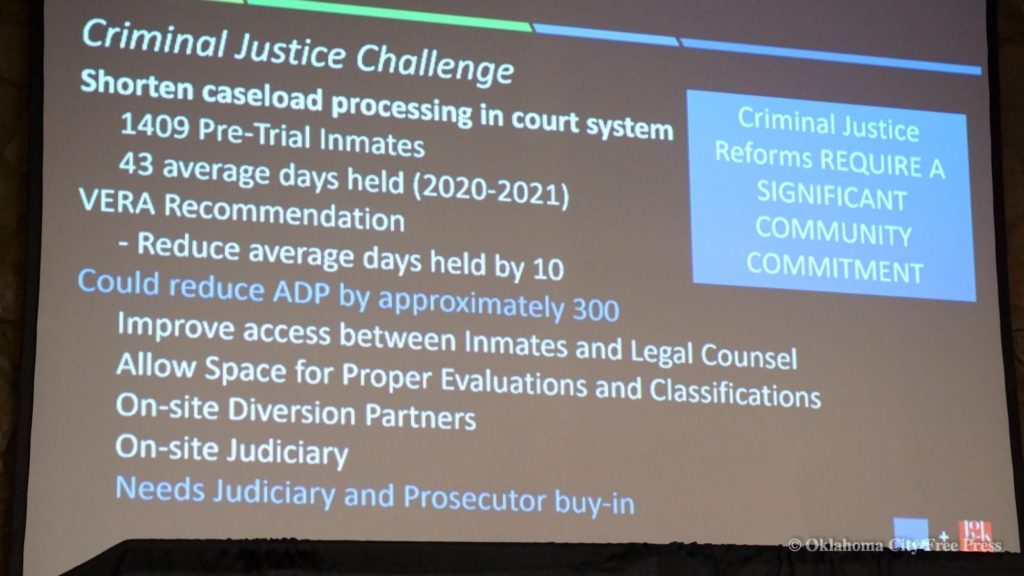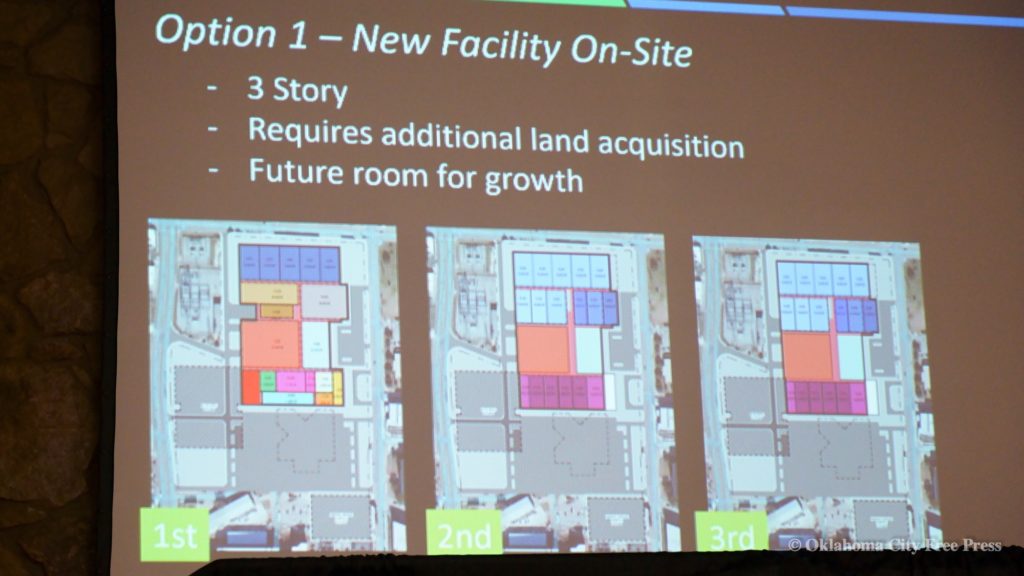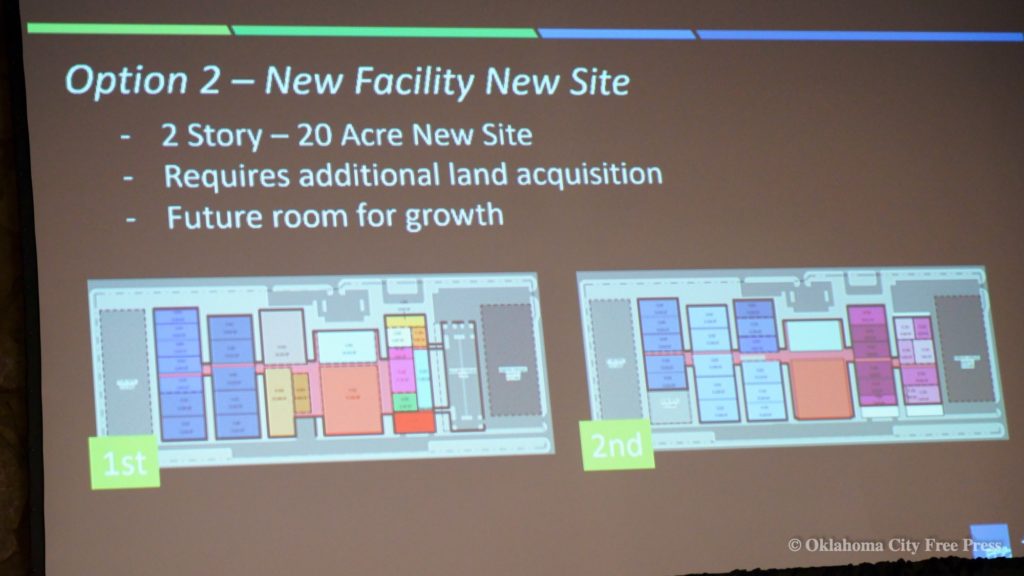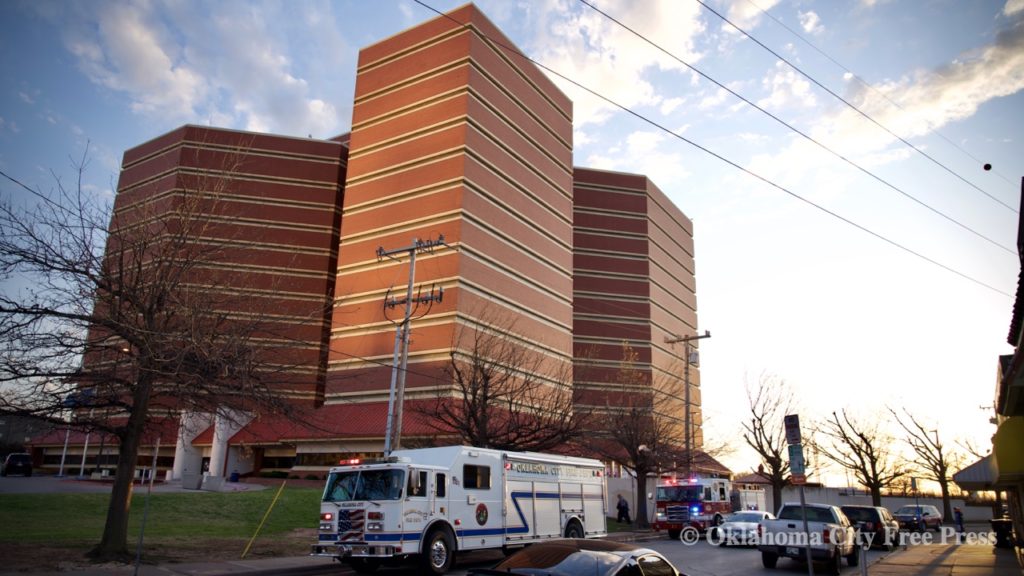Last Updated on October 13, 2021, 7:16 AM | Published: October 11, 2021
OKLAHOMA CITY (Free Press) — Leaders of the second listening session on possible solutions for the problematic Oklahoma County Detention Center or Jail found themselves facing an angry crowd Thursday night.
Without preparing participants for the time frame, the presentation part of the session by the panel on possible solutions took one hour and ten minutes of the announced hour and thirty-minute session.
To at least half of the crowd, it seemed like an intentional effort to force “listening” to the ideas of the architectural firm hired to do an extensive study of problems and possible solutions while giving only a short time to public input.
“You lost me tonight,” said attendee Sean Cummings during his three minutes. “You really lost me.”
“You asked a bunch of victims and survivors of this county jail to come out here and have a discussion on the county jail and we are here,” said Sara Bana. “Instead, you utilized and exploited and victimized us so you can have a pitch!”
As it turned out, moderators gave everyone a turn to speak and went beyond the announced meeting time frame.
But, when members of the panel started to speak again, some attendees said, “we’ve heard enough” and a sizable portion of the crowd simply stood up and walked out ending the meeting.
Several in the crowd during their comments said that it looked like the solution had already been decided and would benefit the architects more than anyone.
It created a sharp contrast to the first session August 12 where participants had been given ample time to voice their concerns and many participants seemed to go away with a sense that they had been heard.
See our earlier coverage: Pain, anger dominate public listening session on Oklahoma County Jail
Thursday night didn’t go the same way.
Agreed upon problems
Critics and those in the solutions business do agree on one thing: The Jail has to undergo serious change.
During the panel comments, southside Senator Michael Brooks – an attorney who has had clients in the jail – said that in spite of all that has been done to try and improve conditions in the Jail, “it has only gotten worse” and that it was “defective from the beginning.”
Frank Turner, who is in the mental health field was another panelist who was clear that the Jail cannot continue the way it is.
“The one thing that I can say … is we know what’s wrong with the jail, and there’s pretty much nothing right about the Jail,” said Turner.
Candace White is in ReMerge, a diversion and rehabilitation program. She was on the panel and spoke about the inhumane conditions in the Jail as someone who had been there. She provided a perspective as one who had been able to get beyond the Jail cycle through the ReMerge program.
White said that the whole Jail organization has staffing problems with Jail personnel who don’t understand because of their youth and lack of deeper training.
“…they’re treating people like animals — like they don’t matter,” said White.
“And, that’s just … disgusting. I’ve been treated that way. You know, I’m a recovering addict, I have two years clean now. And I’ve been addicted to meth for a little over two decades.
Possible solutions
Solutions proposed to the session after about 25 “stakeholder” meetings with various groups were:
Improve access for arrestees
- to visitors
- to attorneys
- to diversion programs
- to medical and mental healthcare
- to treatment and addiction programs
- to education programs
- to judiciary and support services
- to recreation
- to daylight
The rest of Thursday’s presentation was about how Oklahoma County might proceed to accomplish those goals. John Semtner of the FSB architectural firm led that part of the session. He is employed as a consultant on the study and Jeff Bradley from HOK, a consulting firm for FSB, specializes in the design of courthouses, crime labs, police stations, prisons, jails and government buildings.
A key trend of comments by those two individuals was that the Jail needs to be a place where processes of getting people out of the Jail quickly should take place.
The following slide showed how they envision the Jail operating with a new design and new processes carried out by staff.
Yet, they identified problems that really had to do with other parts of government and the community beyond the powers of the Jail Trust.
The design of a new facility is favored by the consultants who specialize in building new buildings, an aspect not lost on attendees who criticized the presentation as serving the best financial interests of the two consulting firms.
Each of the three options, which will come in at around $350 million estimated, involve purchasing land north across the street from the existing Jail campus to afford room for a three-story expansive facility.
Another panelist was Dan Straughan, executive director of the Oklahoma City Homeless Alliance. He held out for a comprehensive approach.
“As a community, we can fix the process and the jail and that’s what we have to do,” said Straughan.
Response
In general, those commenting criticized the proposals for assuming that there would still be the same number of arrests or higher, because of population growth.
Those present were there to argue that current systems of diversion are not even being fully utilized. They argued that the judicial system itself needs to be reformed as well as the ways in which people are arrested and booked into Jail for a number of needs that could be met short of arrest and charges.
Kris Steele, Executive Director of The Education and Employment Ministry (TEEM) has worked for criminal justice reform in Oklahoma for years.
He was one of those who spoke during the public comments time.
“Respectfully, for the architects, for you to say that the jail built several years ago wasn’t big enough may be the most disheartening thing I’ve ever heard,” said Steele. “It’s not that the jail wasn’t built big enough. We incarcerate too many people. We have to move away from that mindset. We have to understand that there is a difference between accountability and punishment.”
And, in direct opposition to the fundamental design elements proposed in the architects’ presentation, Steele said, “Understand that the diversion programs should not be taking place inside of a detention center, they should be designed to take place in the community.”
Steele and other commenters made the point that the problem was that diversion programs were not being utilized.
Another commenter said, “the Oklahoma county jail is a small piece of Hell.”
Setback
Thursday’s session was clearly a setback for the organizing group called Oklahoma County Criminal Justice Advisory Council or CJAC, a project of the Greater Oklahoma City Chamber of Commerce. It was formed to find solutions to what most parties believe is an untenable situation with the current Jail.
It was CJAC’s idea to form the Oklahoma County Jail Trust and turn over the Jail to the trust, which the Oklahoma County commissioners did with considerable controversy reported by Free Press over a year.
CJAC is made up of community leaders, some of those inarguably wealthy, police officials, judges, and others who are a part of the mental health efforts in Oklahoma County.
The influence of the wealthiest people in the community on CJAC and the Jail Trust is not lost on those who advocate for the poorest in the community who often end up in Jail without any recourse.
In a snub to those wealthy individuals Thursday night, Sara Bana suggested “if CJAC wants a new Jail, let them build it.” The comment was met with loud applause and shouts.
Trust organization questioned
Mark Faulk, a well-known activist in OKC, slammed CJAC as “not a real organization.” He contended in his statements that the Jail Trust is “illegal” because the people did not have a chance to vote on it.
But, Timothy Tardibono, the Chamber’s staffer who has been the organizer of CJAC told Free Press that in fact, the type of trust that is the Jail Trust is legal.
Tardibono said that the Jail Trust is organized as a Title 60 trust “that allows citizens to be appointed.” He said that CJAC did not recommend to the Oklahoma County Commissioners to organize the trust under Title 19 which would have required a vote of the people because it would set up essentially a mini budget board with the three commissioners and the Sheriff that had not historically gotten along.
But, the optics of a trust that was not voted into existence continues to create friction with a certain element of the actively involved public that doesn’t show signs of going away.
As one person said to Free Press after the meeting, “I would rather have the county sheriff in charge of the jail. At least we elect that position.”
We asked Tardibono to answer a few questions about the session and the future of engagement with the public on the matter.
To make sure his responses are fully in the context of the questions we asked, we include this Q and A with original questions and full answers. We appreciate his willingness to answer these questions.
Q and A with Timothy Tardibono
- Why did the presentation take over an hour of a meeting that had been announced to last an hour an a half?
Tardibono: It was never our intention to go too long. However, the problems facing the county detention center facility are multi-faceted, involving the criminal justice process before, during, and after a person’s stay at the detention center. This isn’t just about a building, but the building’s disrepair and poor design makes serving arrestees so much harder. We obviously erred on the side of over-sharing information rather than not providing enough information to the public.
- Did you anticipate that some who came out ready to contribute would be upset when it looked like the presenters were running out the clock?
Tardibono: We recognized that the time would be tight and could run over and the church was agreeable to going later than 8:30 pm which we are grateful for. I should have made that clearer to the audience. Every person that stood in line to speak had that opportunity. But I will do better in the future.
- Are plans already set for what will happen on the jail next? That seemed to be the impression on the part of some.
Tardibono: Absolutely not. We aren’t done refining and improving the proposals and taking feedback. There are several steps left. We were pretty clear at the end when we outlined next steps and we expect further revisions along the way.
- What will happen in the process next?
Tardibono: After adjusting the options further, the full CJAC will see more updates later this month and hopefully start narrowing the options. The consultant team will then take that feedback and move toward a final slate of options. Before Thanksgiving, the CJAC will make recommendations which will be given to county officials. After that, CJAC will be available to provide further assistance, while also continuing the focus on the work of improving criminal justice processes.
Founder, publisher, and editor of Oklahoma City Free Press. Brett continues to contribute reports and photography to this site as he runs the business.




